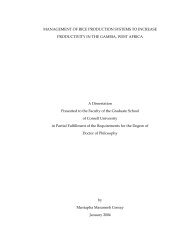Revised proceedings - The System of Rice Intensification - Cornell ...
Revised proceedings - The System of Rice Intensification - Cornell ...
Revised proceedings - The System of Rice Intensification - Cornell ...
Create successful ePaper yourself
Turn your PDF publications into a flip-book with our unique Google optimized e-Paper software.
THE CRITICAL FACTORS OF SRI<br />
– <strong>Rice</strong> is water loving plant but we treated an aquatic<br />
plant.<br />
– <strong>Rice</strong> seedlings lose much <strong>of</strong> their growth potential if<br />
they are transplanted more than 15 days after they<br />
emerge in their nursery.<br />
– During transplanting, trauma to seedlings and<br />
especially to their roots should be minimized.<br />
– Wide spacing <strong>of</strong> plants will lead to greater root<br />
growth and accompanying tillering.<br />
– Soil aeration and organic matter create beneficial<br />
conditions for plant root growth<br />
THE CRITICAL FACTORS OF SRI<br />
4. To Transplant the seedlings far apart,<br />
• One seedling per hill<br />
• Relatively few plants per m 2<br />
• In some soils, 2 plants per hill may give more<br />
tillers per m 2<br />
• More plants in a hill will create inhibitions on root<br />
growth due to competition<br />
5. To transplant in a square pattern to facilitate weeding.<br />
• <strong>The</strong> most common SRI spacing is 25 x 25 cm,<br />
• With good soil conditions, the hills can be up to 50<br />
x 50 cm apart.<br />
• With a square pattern, weeding can be done in<br />
perpendicular rows.<br />
THE CRITICAL FACTORS OF SRI<br />
7. To control weeds, early and frequent<br />
weeding.<br />
• This is best done with a simple<br />
mechanical hand weeder <strong>of</strong>ten called a<br />
'rotating hoe,' starting about 20 days after<br />
transplanting.<br />
• At least once more and if possible 2 or 3<br />
times more, until canopy closure makes<br />
weeding difficult and no longer necessary.<br />
8. To add nutrients to the soil, preferably in<br />
organic form such as compost or mulch.<br />
Objectives <strong>of</strong> the research work<br />
<strong>The</strong> study has been undertaken with following<br />
objectives:<br />
• To find out the effect <strong>of</strong> crop establishment time and<br />
seedling age on crop performance <strong>of</strong> Boro rice under<br />
SRI.<br />
• To find out the water management and soil stirring<br />
effect on the performance <strong>of</strong> Boro rice under SRI<br />
• To find out the effect <strong>of</strong> spacing and seedling raising<br />
method on crop performance <strong>of</strong> Boro rice under SRI<br />
• To find out the integrated use <strong>of</strong> manure and fertilizer<br />
on crop performance in Boro season under SRI<br />
• To find out the critical factors for higher performance<br />
<strong>of</strong> Boro crop under SRI<br />
49<br />
THE CRITICAL FACTORS OF SRI<br />
To give effect to these factors, SRI is communicated in<br />
terms <strong>of</strong> a set <strong>of</strong> practices or techniques which should be<br />
understood as starting points for experimentation and for<br />
fitting SRI to local conditions.<br />
1. To start transplanting by young seedlings<br />
• Preferably 8-12 days old and not more than 15 days<br />
• When the plant still has just two small leaves and<br />
the seed sac is still attached to the root<br />
2. To transplant seedlings quickly and carefully<br />
Allowing only 15-30 minutes between uprooting from<br />
the nursery and planting in the field<br />
3. Seedlings should be put 1-2 cm deep into soil that is muddy<br />
but not flooded.<br />
<strong>The</strong>y should be laid into the soil with care, with roots<br />
lying horizontally so that their root tips are not pointing<br />
upward<br />
THE CRITICAL FACTORS OF SRI<br />
6. Keep the soil well drained<br />
– No need to keep water continuously flooded during<br />
the vegetative growth period.<br />
– Panicle initiation stage, keep only a thin layer <strong>of</strong> water<br />
on the field until 10-15 days before harvest,<br />
A. Apply small amounts <strong>of</strong> water daily<br />
– Just as much as needed to keep the soil moist and<br />
saturated, but no standing water.<br />
– During tillering stage, the field should be left to<br />
dry out for several short periods (2-6 days), to the<br />
point <strong>of</strong> surface hairy cracking,<br />
B. Alternate Flooding and drying the field<br />
– For alternating periods <strong>of</strong> 3-6 days each<br />
throughout the period <strong>of</strong> vegetative growth.<br />
An understanding <strong>of</strong> the critical factors<br />
<strong>of</strong> SRI underlying the higher productivity<br />
is yet to be developed.<br />
It is needed to establish agro<br />
ecologically suited critical factors <strong>of</strong> SRI<br />
for sustainable productivity.<br />
It is also needed to validate and<br />
promote SRI technology for uptake to<br />
Bangladeshi farmers.<br />
Methodology to be followed<br />
• <strong>The</strong> proposed research has been carried out at the<br />
BRRI research farm at Gazipur.<br />
• Total Six experiments will be conducted to fulfill the<br />
above objectives.<br />
• Experiments No. 1, 2, 3, 4 and 5 have been already<br />
experimented.<br />
• Based on the 1st year performance <strong>of</strong> experiments No.<br />
1, 2, 3 and 4, Experiment No 5 has been designed for<br />
2nd year.<br />
• In 3rd year, experiment No. 6 has been under taken.

















